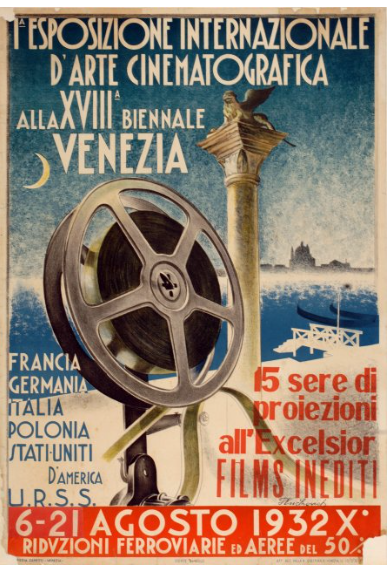The International Exhibition of Cinematographic Art (commonly known as the Venice Film Festival) is turning 91 years old!
The festival takes place annually in Venice, Italy, between the end of August and the beginning of September at the historic Palazzo del Cinema on the Marconi waterfront and in nearby buildings, on the Lido of Venice, and throughout the lagoon.
The main prize is the Golden Lion, named after the symbol of the city, the Lion of St. Mark. This recognition is considered one of the most important from a film critic’s perspective, along with those awarded at the other two major European film festivals, Palme d’Or of the Cannes Film Festival and the Golden Bear of the Berlin International Film Festival.
Each year, 140 films are screened, including feature films, documentaries, and special projects.
After the Oscars, it is the oldest film festival in the world, with the first edition held between August 6th and 21st, 1932.
Prominent at the first festival were the biggest international stars of the time, such as Greta Garbo, Clark Gable, Joan Crawford, and the Italian idol Vittorio De Sica. Their presence brought the exhibition greater success than expected at more than twenty-five thousand spectators.
In the post-war forties, the exhibition again hosted great international directors such as Orson Welles, Laurence Olivier, Fritz Lang, John Huston, and others.
In the fifties, the importance of the festival was recognized internationally. It saw a period of strong expansion and contributed to the establishment of new cinema schools, such as the Japanese and Indian schools, with the arrival of their greatest directors and stars.
The sixties were the years of protest, and the Venice Film Festival was no exception: the Golden Lion was not awarded to Luchino Visconti’s extraordinary film, Rocco and His Brothers, but to the Frenchman André Cayatte’s The Crossing of the Rhine.
The seventies saw the introduction of a Golden Lion for career achievement, which had as its first recipients the American director John Ford, who had been present at the festival several times, and, the following year, Charlie Chaplin.
The nineties saw the arrival of young American directors such as Spike Lee and Gus Van Sant.
Italian director Gillo Pontecorvo became the curator of the exhibition in 1992, with the program of making Venice the capital of film, physically bringing back the great directors and stars to the Lido of Venice and revitalizing the Palazzo del Cinema with the presence of young people. His many initiatives and events brought new life to the festival.
In the 2000s, there has been a strong focus on strengthening the infrastructure, adding new venues renovated or created specifically for the festival, improving connections between the different areas, and bringing the total exhibition space to over 11,000 square meters (118,000 square feet).
The 21st Century festival continues to be an effective showcase for new talent looking to attract international attention.
